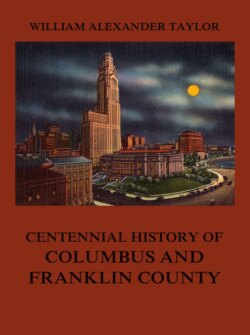Читать книгу Centennial History of Columbus and Franklin County - William Alexander Taylor - Страница 8
На сайте Литреса книга снята с продажи.
Оглавление
The First Mill East of the River.
"In 1790 or 1800 Robert Balentine," says the early historian, "erected a poor kind of a mill" on the Run, near the present line of Gay street, but whether east or west of Gay street it is not stated. The Run, however, is not there at the present writing.
The First Up-River Mill.
"At about the same period John D. Rush erected," in the frank language of the historian, "an inferior mill on the Scioto a short distance above Franklinton." They were, however, both poor concerns and soon fell into ruins, and clearly enough the "sound of the grinding" was not only "low," but the grasshopper had no musical rival to divide the honors with him; but not for long.
The First Horse Mill.
Then, as a last resort, some pioneer, whose name is lost to immortal fame, erected a horse mill and managed to eke out sufficient corn meal to meet the demand of the growing metropolis.
The First Successful Mill.
Then it was, in 1805, that at a point near Worthington, Colonel James Kilbourne erected a mill imbued, as it were, with the spirit of the eighteenth century. It was a mill built on modern lines and principles and turned out wheat and buckwheat flour and corn meal in a steady stream and started Franklin county on the road to greatness, and after this there were mills and mills erected on all the streams in the vicinity of Columbus; men laid by a competence for themselves; became more than honest millers—leading citizens of county and state, whose names will continue to grace and ornament the general local annals for decades, and in many instances for centuries yet to come, as may be well and truly said of the proprietors of Carpenter's Mill on the Whetstone, Dyer's Mill on Darby, Nelson's on Alum creek and others contemporaneous with them in the first decade and the first half of the second decade of the century.
The First Mercantile Venture.
Nearly all, if not all, beginnings are small, and in accordance with that recognized law it is to be expected that the first things are small, although when we contemplate them in their fully developed form it staggers our credulity to think of them as merely tiny bubbles on the ocean of mercantile adventure.
Mr. James Scott in 1798 or 1799, the precise date being in doubt, opened "the first small store in Franklinton, which added much to the convenience of the settlers." It was certainly a great convenience to the Franklinton housewife, since she could get breakfast, wash the dishes, tidy up the cabin, go to Mr. Scott's store, purchase three yards of brown muslin and a skein of thread, return home and cut out and make a shirt for her husband, get dinner and supper meantime, and have the garment finished in time for her husband to wear down to "the public square," where the men folks met and told hunting stories in the gloaming of the forest twilight and on contemporaneous subjects, while her ears tingled, a la telepathy, at the praises of the young men touching the neat hemming and hemstitching on the shirt aforesaid.
The next store, and probably a larger one, was started by Robert Russell, Esquire, in 1803. So far as can be learned, there are now no direct successors to those merchant princes of the then unbuilt city.
